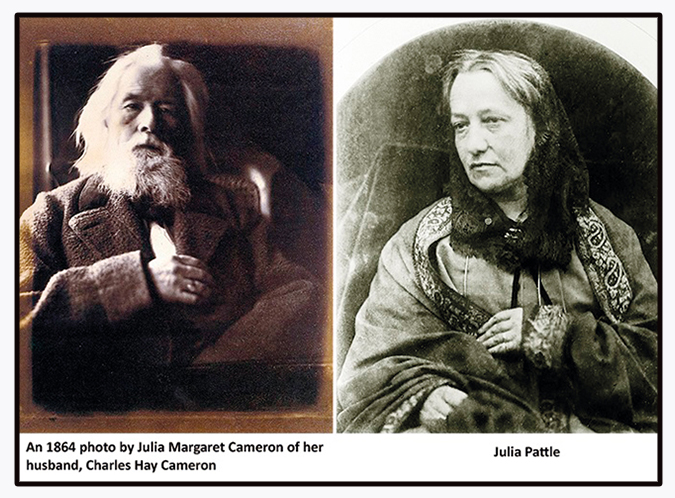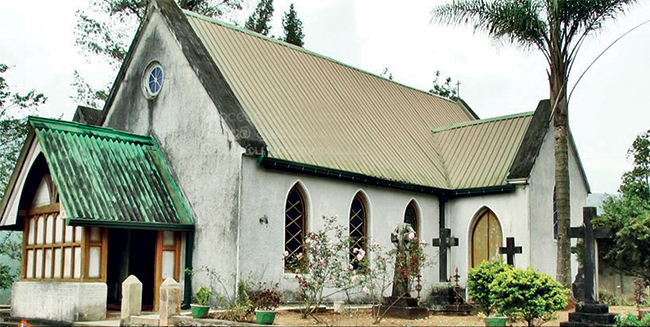Features
The Story of Julia Margaret and Charles Cameron

A Little Bit of Ceylon; A Little Bit of England
by Leelananda De Silva
A fascinating bit of colonial history and of British days in the island, lies buried in the remote churchyard of St. Mary’s in Bogawantalawa. The tombs of Julia Margaret Cameron and Charles Hay Cameron stand next to each other, relatively neglected, unknown and unvisited.
It is probably true to say that the Camerons, husband and wife, are the most important British couple in the annals of colonial times in Sri Lanka. No other couple of that significance comes to mind. Julia Margaret (JM) has now been recognized as one of the earliest and greatest photographers England produced. Recently, the National Portrait Gallery (NPG) in London held an exhibition of JM’s photographs to wide acclaim. Nearly 150 photographs were displayed, of which ten were those taken by her in Ceylon (in Kalutara and in the upcountry).
In the book published by the National Portrait Gallery for the occasion she is described as the “19th Century Photographer of Genius”. Charles has an honoured place in the constitutional history of this island. He was part of the Colebrooke Cameron Commission of 1832 which laid the groundwork for Ceylon’s evolving political and legal system.
JM started life as a Pattie, her maiden name, having being born in India in 1815 – one of 10 children, and was brought up mainly by her maternal grandmother in Paris and Versailles. Her family held high office in what was then the East India Company. She married Charles Hay Cameron, 20 years her senior, in 1838. In that year, Charles had succeeded the famous Macaulay as the President of the Law Commission in India and in 1843 took Macaulay’s place as a member of the ruling Supreme Council.
On their return to England JM and Charles lived in various places and finally settled at Freshwater on the Isle of Wight, an hour’s ferry ride from the English seaside town of Lymington. There they established themselves in “Dimbola Lodge” (now the Julia Margaret Museum). Between 1840 and 1844, the Camerons had purchased coffee plantations in Ceylon and one of them was Dimbola Estate.
In Freshwater the Camerons were next door neighbours and intimate friends of the poet, Alfred, Lord Tennyson whose house is now a hotel adjoining the museum. Having been given a camera, JM started on her amateur career as a photographer. Her family and social connections gave her access to famous men and women (Tennyson, Charles Darwin, the then Crown prince and princess of Germany, the latter being the daughter of Queen Victoria, Longfellow, Anthony Trollope, Robert Browning), and she photographed them all.
JM’s photographs have immortalized all these Victorian icons. JM’s sister’s daughter, another Julia, married Sir Leslie Stephen, the editor of the Dictionary of National Biography, and she was the mother of Virginia Woolf. In a way, the Camerons were the grandparents’ of the Bloomsbury Group, with whom there is a later Ceylon connection in the form of Leonard Woolf.
In the 1870’s, the Camrons left England to settle down in Ceylon, where their three children were, two of them planters, and one of them, Hardinge, a civil servant and Secretary to the Governor. Hardinge also served in Kalutara as the Assistant Government Agent. For a time the Camerons were in Kalutara and later moved to Balmoral Cottage in Lindula and then to Glencairn Estate not far away.
The eccentricities of the Camerons were on view in the arrangements they made for the long voyage to Sri Lanka. They took with them two cows, to obtain fresh milk and two coffins! The Camerons lived through a time of great difficulty for coffee planters in Ceylon. It is almost certain that JM used the camera extensively while in Ceylot although only ten photographs have ben discovered.
Marianne North, the botanic painter visited the Camerons in 1877 and stayed with them in Kalutara. She speaks of JM using her camera often. North herself did some paintings there and they are now to be viewed in her collection of paintings at Kew Gardens. JM passed away in 1879 and Charles in 1880. JM’s body was brought 16 miles from Glencairn Estate by ox cart to be interred in the churchyard at Bogawantalawa.
The graves of Julia Margaret Cameron and her husband, Charles Hay Cameron, 2017. Courtesy Stephen White.
Charles Hay Cameron is hardly known in England. He was a leading Indian jurist. His importance in Ceylon lies in his association with Colebrooke to bring about constitutional reforms. His signal contribution was on the judicial side and his ‘Report on the Judicial Establishments and Procedure’ is a landmark in establishing the rule of law in this country.
Following on his recommendations to create a unified system of justice in the country with all persons equal before the law, he was largely responsible for drafting the Charter of Justice in 1833. Cameron was also responsible for drafting the Indian Penal Code. Cameron was a follower of Jeremy Bentham, the utilitarian philosopher, and in his legal work was influenced by Benthamite liberalism.
The diverse, strands of the Cameron lives ran through Victorian England, India and Ceylon. Three worlds met in their life and activities that of the Victorian upper-middle class, the intellectual coterie of liberal and utilitarian philosophy and jurisprudence, and that of the planting community in Ceylon’s hill country.
There have not been many planters living in Ceylon with this kind of esoteric background. This was a rare blend. We do not know how the Camerons moved in the philistine world of plantation society at the height of the British Empire. Did they have the same qualms as Leonard Woolf in later years?
With these achievements, and their connections with this country, Julia Margaret and Charles deserve a fitting memorial. There has been considerable activity recently to celebrate the centenary of the arrival of Leonard Woolf to this country in 1904. He deserves it. His novel, ‘Village in the Jungle’ and also his Ceylon diaries are literary landmarks.
The Camerons are the direct ancestors of Leonard’s wife, Virginia (Virginia Woolf wrote a play ‘Freshwater’ named after the village on the Isle of Wight, about her grand-aunt). They equally deserve to be recognized in this country for their contributions.
We visited St. Mary’s Anglican Church in Bogawantalawa, recently. The parish priest, Rev. M. Devasagayam, has given some recognition to the Camerons by naming a childcare centre after Julia Margaret. The church itself was founded by the Camerons in 1878, and there is a stained glass window, which they themselves had brought from England, in their memory.
The British Council, the Tourist Board, the Photographic Society, and may be even the Ministry of Justice and other judicial authorities can take further action to create that lasting memorial for the Camerons.
